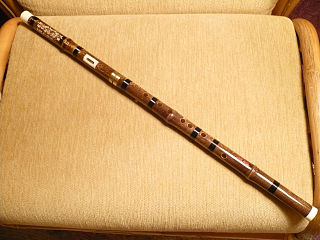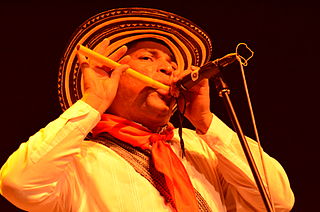The clarinet is a single-reed musical instrument in the woodwind family, with a nearly cylindrical bore and a flared bell.

Woodwind instruments are a family of musical instruments within the greater category of wind instruments. Common examples include flute, clarinet, oboe, bassoon, and saxophone. There are two main types of woodwind instruments: flutes and reed instruments. The main distinction between these instruments and other wind instruments is the way in which they produce sound. All woodwinds produce sound by splitting the air blown into them on a sharp edge, such as a reed or a fipple. Despite the name, a woodwind may be made of any material, not just wood. Common examples include brass, silver, cane, as well as other metals such as gold and platinum. The saxophone, for example, though made of brass, is considered a woodwind because it requires a reed to produce sound. Occasionally, woodwinds are made of earthen materials, especially ocarinas.

A reed is a thin strip of material that vibrates to produce a sound on a musical instrument. Most woodwind instrument reeds are made from Arundo donax or synthetic material. Tuned reeds are made of metal or synthetics. Musical instruments are classified according to the type and number of reeds.

The ney, is an end-blown flute that figures prominently in Persian music, Turkish music and Arabic music. In some of these musical traditions, it is the only wind instrument used. The ney has been played continually for 4,500–5,000 years in ancient Egypt, making it one of the oldest musical instruments still in use.

The shawm is a conical bore, double-reed woodwind instrument made in Europe from the 12th century to the present day. It achieved its peak of popularity during the medieval and Renaissance periods, after which it was gradually eclipsed by the oboe family of descendant instruments in classical music. It is likely to have come to Western Europe from the Eastern Mediterranean around the time of the Crusades. Double-reed instruments similar to the shawm were long present in Southern Europe and the East, for instance the ancient Greek, and later Byzantine aulos, the closely related sorna and zurna, and the Armenian duduk.

The chalumeau is a single-reed woodwind instrument of the late baroque and early classical eras. The chalumeau is a folk instrument that is the predecessor to the modern-day clarinet. It has a cylindrical bore with eight tone holes and a broad mouthpiece with a single heteroglot reed made of cane. Similar to the clarinet, the chalumeau overblows a twelfth.
The arghul, also spelled argul, arghoul, arghool, argol, or yarghul, is a musical instrument in the reed family. It has been used since ancient Egyptian times and is still used as a traditional instrument in Egypt palestine, Syria and Jordan.

The tenor saxophone is a medium-sized member of the saxophone family, a group of instruments invented by Adolphe Sax in the 1840s. The tenor and the alto are the two most commonly used saxophones. The tenor is pitched in the key of B♭ (while the alto is pitched in the key of E♭), and written as a transposing instrument in the treble clef, sounding an octave and a major second lower than the written pitch. Modern tenor saxophones which have a high F♯ key have a range from A♭2 to E5 (concert) and are therefore pitched one octave below the soprano saxophone. People who play the tenor saxophone are known as "tenor saxophonists", "tenor sax players", or "saxophonists".

The zhaleika, also known as bryolka (брёлка), is a Slavic wind instrument, most used in Belarusian, Russian and sometimes Ukrainian ethnic music. Also known as a "folk clarinet" or hornpipe. The zhaleika was eventually incorporated into the balalaika band, the Hungarian tarogato, and may have contributed to the development of the chalumeau, a predecessor of the clarinet.

The Basque alboka is a single-reed woodwind instrument consisting of a single reed, two small diameter melody pipes with finger holes and a bell traditionally made from animal horn. Additionally, a reed cap of animal horn is placed around the reed to contain the breath and allow circular breathing for constant play. In the Basque language, an alboka player is called albokari. The alboka is usually used to accompany a tambourine singer.

A double reed is a type of reed used to produce sound in various wind instruments. In contrast with a single reed instrument, where the instrument is played by channeling air against one piece of cane which vibrates against the mouthpiece and creates a sound, a double reed features two pieces of cane vibrating against each other. This means, for instruments with the double reed fully exposed, that the air flow can be controlled by the embouchure from the top, bottom and sides of the reed. The term double reeds can also refer collectively to the class of instruments which use double reeds.

The term double clarinet refers to any of several woodwind instruments consisting of two parallel pipes made of cane, bird bone, or metal, played simultaneously, with a single reed for each. Commonly, there are five or six tone holes in each pipe, or holes in only one pipe while the other acts as a drone, and the reeds are either cut from the body of the instrument or created by inserting smaller, slit tubes into the ends of the pipes. The player typically uses circular breathing.

The bawu is a Chinese wind instrument. Although shaped like a flute, it is actually a free reed instrument, with a single metal reed. It is played in a transverse (horizontal) manner. It has a pure, clarinet-like timbre and its playing technique incorporates the use of much ornamentation, particularly bending tones.

A single-reed instrument is a woodwind instrument that uses only one reed to produce sound. The very earliest single-reed instruments were documented in ancient Egypt, as well as the Middle East, Greece, and the Roman Empire. The earliest types of single-reed instruments used idioglottal reeds, where the vibrating reed is a tongue cut and shaped on the tube of cane. Much later, single-reed instruments started using heteroglottal reeds, where a reed is cut and separated from the tube of cane and attached to a mouthpiece of some sort. By contrast, in a double reed instrument, there is no mouthpiece; the two parts of the reed vibrate against one another. Reeds are traditionally made of cane and produce sound when air is blown across or through them. The type of instruments that use a single reed are clarinets and saxophone. The timbre of a single and double reed instrument is related to the harmonic series caused by the shape of the corpus. E.g. the clarinet is only including the odd harmonics due to air column modes canceling out the even harmonics. This may be compared to the timbre of a square wave.
The guan is a Chinese double reed wind instrument. The northern Chinese version is called guanzi or bili and the Cantonese version is called houguan. It is classified as a bamboo instrument in the Ba Yin system. Unlike other instruments in the double-reed family of woodwinds which mostly have conical bores, such as the Chinese suona or the Western oboe, the guan has a cylindrical bore, giving its distinctive mellow, yet piercing buzz-like timbre.
Diplica or diplice is a single-reed instrument from the Balkans, which has been playing in different forms through many parts of Croatia, but now survives mainly in the Baranya region.

The mock trumpet is a single-reed woodwind instrument popular during the second half of the seventeenth century, especially in England. By the 1720s, the mock trumpet was documented in use in the New World.

The caña de millo, flauta de millo or pito atravesao is a woodwind musical instrument of indigenous origin used in the cumbia music of Colombia's Caribbean coast.

Mechanical music technology is the use of any device, mechanism, machine or tool by a musician or composer to make or perform music; to compose, notate, play back or record songs or pieces; or to analyze or edit music. The earliest known applications of technology to music was prehistoric peoples' use of a tool to hand-drill holes in bones to make simple flutes. Ancient Egyptians developed stringed instruments, such as harps, lyres and lutes, which required making thin strings and some type of peg system for adjusting the pitch of the strings. Ancient Egyptians also used wind instruments such as double clarinets and percussion instruments such as cymbals. In Ancient Greece, instruments included the double-reed aulos and the lyre. Numerous instruments are referred to in the Bible, including the horn, pipe, lyre, harp, and bagpipe. During Biblical times, the cornet, flute, horn, organ, pipe, and trumpet were also used. During the Middle Ages, hand-written music notation was developed to write down the notes of religious Plainchant melodies; this notation enabled the Catholic church to disseminate the same chant melodies across its entire empire.














